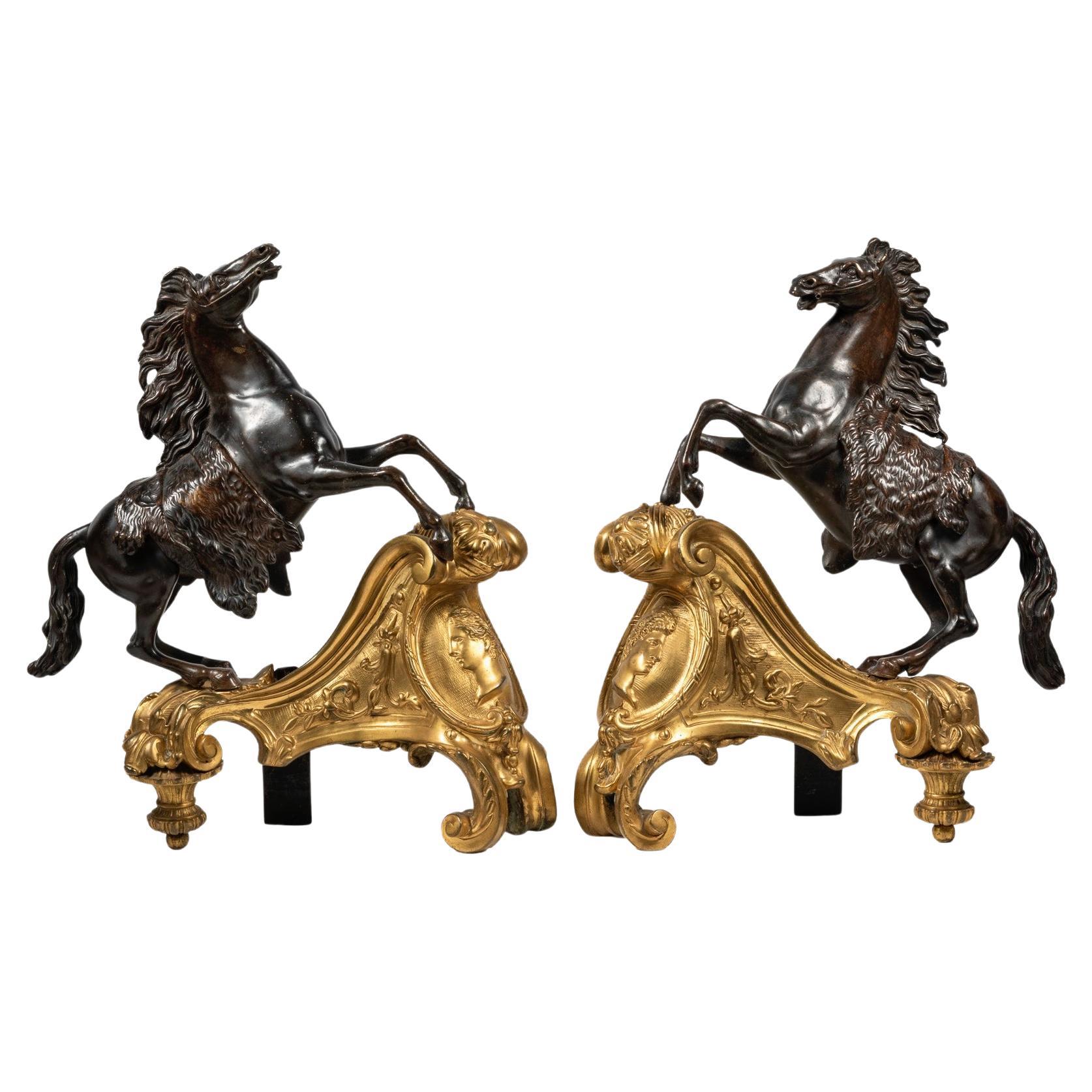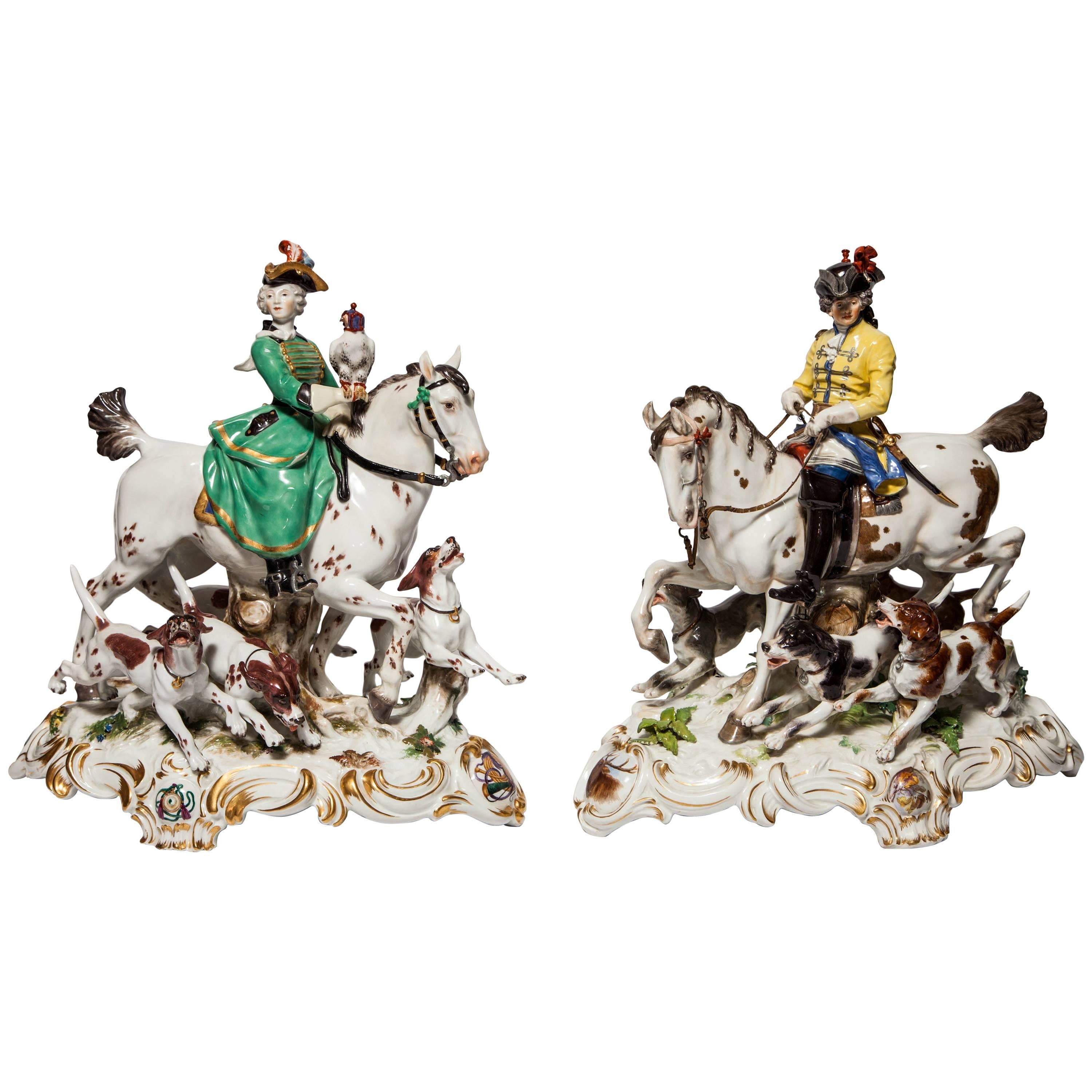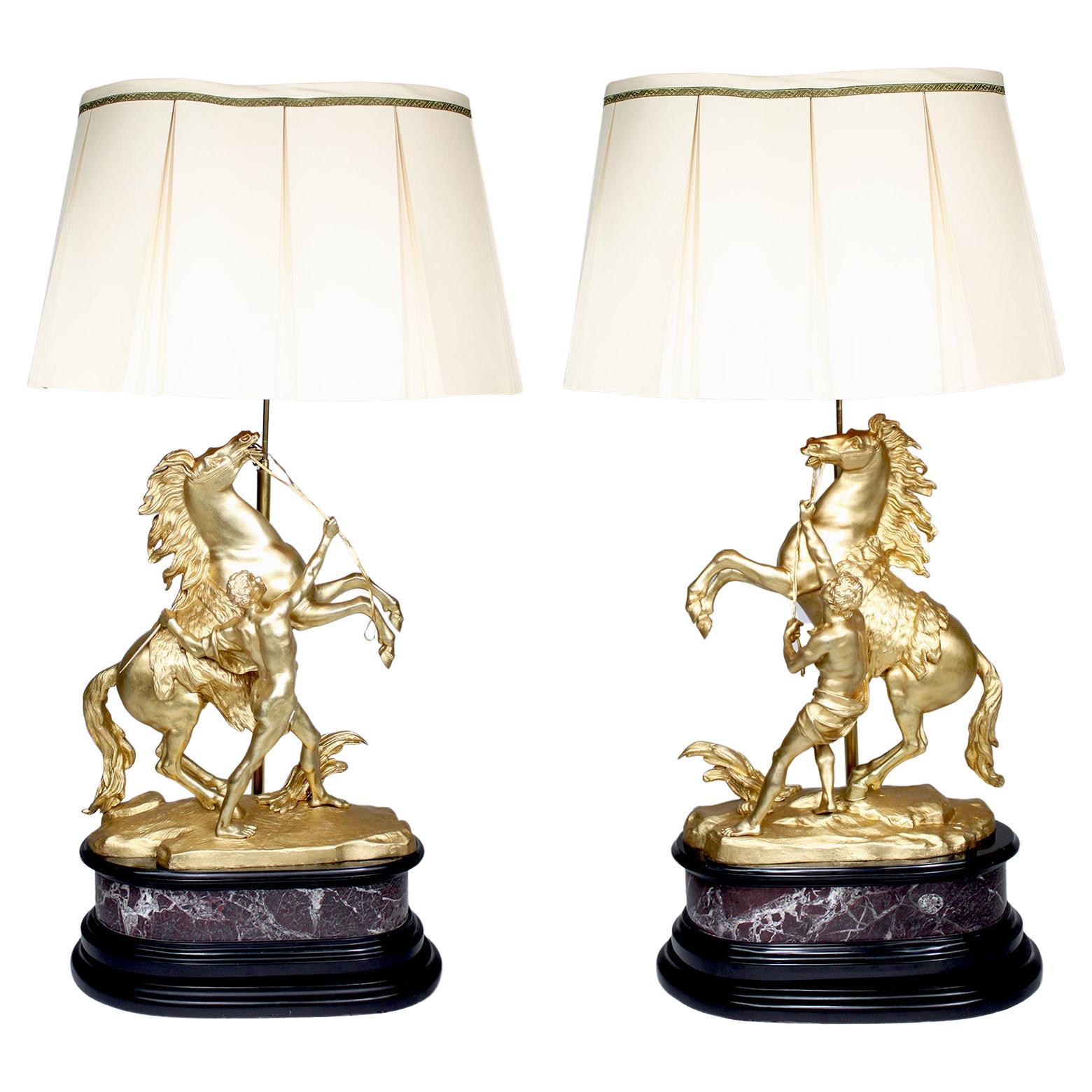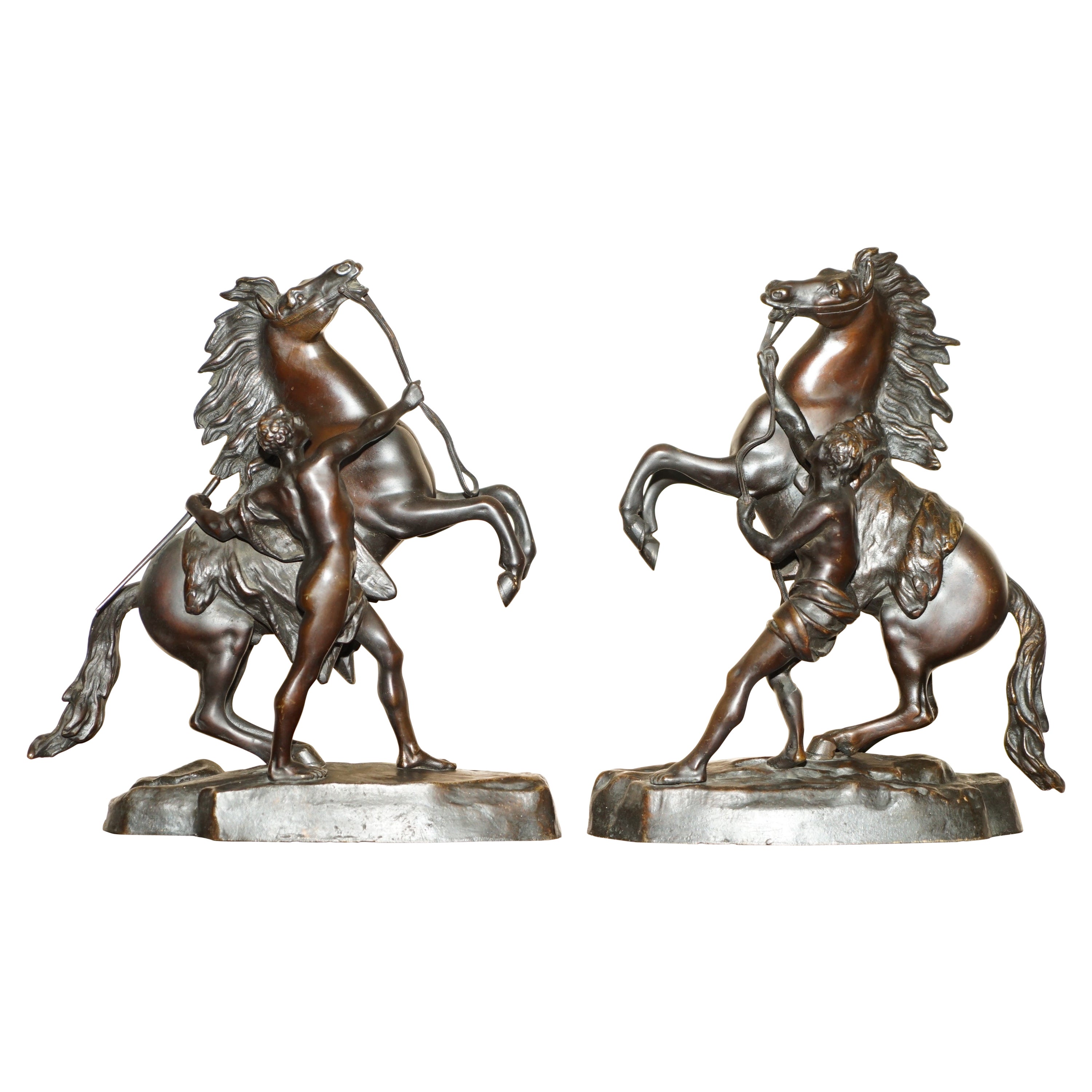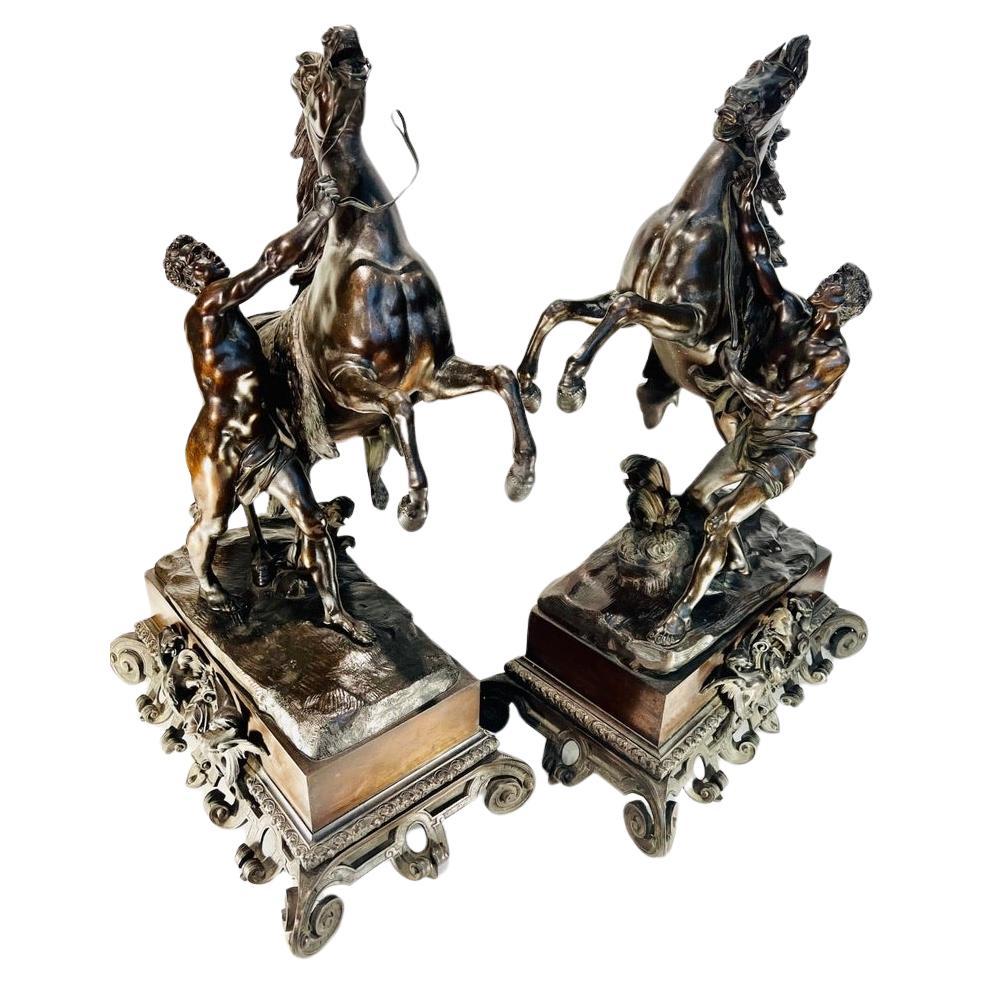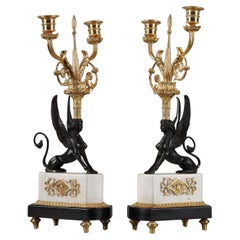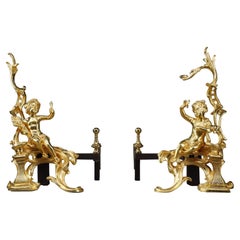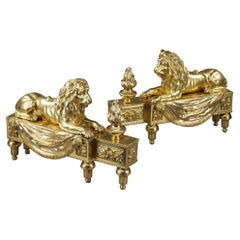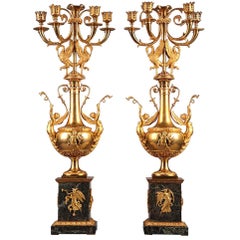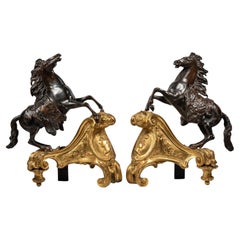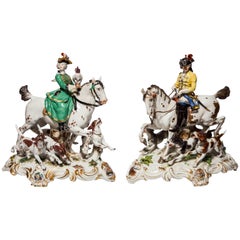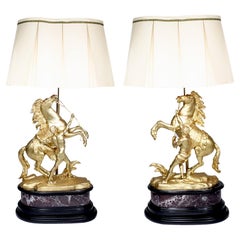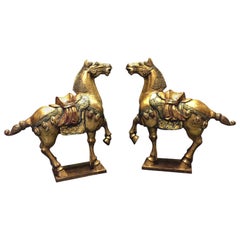Items Similar to Ormolu-Mounted Porcelain Horses by Samson Manufactory
Want more images or videos?
Request additional images or videos from the seller
1 of 16
Ormolu-Mounted Porcelain Horses by Samson Manufactory
$3,546.54per set
£2,670.19per set
€3,000per set
CA$4,894.76per set
A$5,483.21per set
CHF 2,851.95per set
MX$66,883.83per set
NOK 36,309.11per set
SEK 34,236.90per set
DKK 22,839per set
About the Item
Pair of 20th century white porcelain horses on clouds, above rocaille bases richly decorated with scrollwork and openwork foliage. Both figures are marked underneath with two crossed blue swords, one of the Samson porcelain factory’s most famous marks registered in 1927 for imitating Meissen porcelains. An identical model is housed in the Chimchirian collection,
Bibliography: Florence Slitine, Samson, ge´nie de l’imitation, Paris, E´dition Charles Massin, 2002, reprod. p. 146,
circa 1930.
Dimension: W 6.7 in, D 5.1 in, H 7.1 in.
Dimension: L 17 cm, P 13 cm, H 18 cm.
- Creator:Samson & Cie (Manufacturer)
- Dimensions:Height: 7.09 in (18 cm)Width: 6.7 in (17 cm)Depth: 5.12 in (13 cm)
- Sold As:Set of 2
- Style:Louis XV (In the Style Of)
- Materials and Techniques:
- Place of Origin:
- Period:
- Date of Manufacture:circa 1930
- Condition:Wear consistent with age and use. A hock with small fabrication chip.
- Seller Location:Paris, FR
- Reference Number:Seller: 16391stDibs: LU2065316800972
About the Seller
4.9
Gold Seller
Premium sellers maintaining a 4.3+ rating and 24-hour response times
Established in 2001
1stDibs seller since 2016
323 sales on 1stDibs
Typical response time: 2 hours
- ShippingRetrieving quote...Shipping from: Montesson, France
- Return Policy
Authenticity Guarantee
In the unlikely event there’s an issue with an item’s authenticity, contact us within 1 year for a full refund. DetailsMoney-Back Guarantee
If your item is not as described, is damaged in transit, or does not arrive, contact us within 7 days for a full refund. Details24-Hour Cancellation
You have a 24-hour grace period in which to reconsider your purchase, with no questions asked.Vetted Professional Sellers
Our world-class sellers must adhere to strict standards for service and quality, maintaining the integrity of our listings.Price-Match Guarantee
If you find that a seller listed the same item for a lower price elsewhere, we’ll match it.Trusted Global Delivery
Our best-in-class carrier network provides specialized shipping options worldwide, including custom delivery.More From This Seller
View AllPair of Candelabras "Aux Sphinges", Directoire Period
Located in Paris, FR
A pair of Directoire period gilt and patinated bronze and black and white marble candelabras. They present a decoration of winged sphinxes in patinated bronze carrying on their heads...
Category
Antique Early 1800s French Directoire Candelabras
Materials
Marble, Bronze
Pair of Andirons in Gilt Bronze, Louis XV Style
Located in Paris, FR
Pair of Louis XV style andirons with rocaille decoration. They are decorated with ormolu and chased putti sitting on a moving base. One putto wearing a crown of wheat is holding a sh...
Category
Antique 1880s French Louis XV Fireplace Tools and Chimney Pots
Materials
Bronze
$5,438 / set
Pair of Andirons with Lions in Gilded and Chiseled Bronze
Located in Paris, FR
Large pair of gilt and finely chiselled bronze andirons in the Louis XVI style. They are surmounted by laying lions on a drape decorated with trimmings facing fire pots...
Category
Antique 1850s French Louis XVI Fireplace Tools and Chimney Pots
Materials
Bronze
Pair of Late 18th Century Gilt Bronze and Marble Candelabra
Located in Paris, FR
Pair of gilded and sculpted bronze candelabra with four branches each. The branches curve to form trumpets and foliated scrollwork on one end and sockets on the other end. The socket...
Category
Antique Late 18th Century French Directoire Candelabras
Materials
Marble, Bronze
Pair or Louis XIV style andirons decorated with seated Muses
Located in Paris, FR
Pair of Louis XIV style ormolu and chased mantel lights decorated with muses seated on gadrooned balls, the base scrolled and foliated. The muses are draped and appear to be conversi...
Category
Antique Early 1900s French Louis XIV Andirons
Materials
Bronze
Naturalist Ormolu Candelabra Lamps in Auguste Cain Taste
By Auguste Nicholas Cain
Located in Paris, FR
Pair of gilt bronze three-light candelabra lamps topped by Dionysus (Bacchus for the Romans) and a Maenad (Bacchante for the Romans). Dionysus is represented wearing the skin of a fa...
Category
Antique 19th Century French Napoleon III Candelabras
Materials
Ormolu, Bronze
You May Also Like
Pair of Patinated and Ormolu Mounted Horse Model Chenets, After Jacques Caffieri
By Jacques Caffieri
Located in New York, NY
A Pair of Highly Elaborate and Quite Impressive Patinated and Ormolu Mounted Horse Model Chenets, After Designs by Jacques Caffieri (1678–1755), the Renowned 18th-Century French Fond...
Category
Antique 1860s French Louis XV Andirons
Materials
Bronze
Exceptional Pair of Antique Meissen Porcelain Hunting Groups with Horses & Dogs
By Meissen Porcelain
Located in New York, NY
An exceptional and quite large pair of 19th century antique Meissen porcelain hunting groups with "The Prince" and "The Princess" each riding a horse followed by a bunch of hunting d...
Category
Antique Late 19th Century Rococo Figurative Sculptures
Materials
Porcelain
Pair French 19th/20th Century Gilt-Bronze Sculptures of The Marly Horses Lamps
By Guillaume Coustou
Located in Los Angeles, CA
A Fine Pair of French 19th/20th Century Gilt-Bronze Sculptures of "The Marly Horses" (Now turned into lamps) After the original by Guillaume Coustou (French, 1677-1746). The large pair of equestrian bronze sculptures, finished in a gold patina, each depicting rearing horses with their groom, both raised on oval a black slate and Bardiglio marble bases and fitted with modern electrical twin-light brass fittings and cream colored shades. The base on an ebonized wooden platform. Circa: Paris, 1900-1920.
Sculpture & Base Height: 31 1/4 inches (79.8 cm)
Base Width: 21 3/4 inches (55.3 cm)
Base Depth: 12 3/4 inches (32.4 cm)
Height to top of (Adjustable) shade fitting: 48 1/4 inches (122.6 cm)
Shade Height: 15 inches (38.1 cm)
Shade Width: 26 inches (66.1 cm)
Shade Depth: 20 inches (50.8 cm)
The original Marly Horses are two 1743–1745 Carrara marble sculpted groups by Guillaume Coustou. They were commissioned by Louis XV of France for the trough at the entrance to the grounds of his château de Marly. Coustou's last works, they were intended to replace two other sculpted groups, Mercury on Pegasus and Pegasus, Renown of Horses, both by Antoine Coysevox, which had been removed to the Tuileries Gardens in 1719.
Louis XV chose the modellos in 1743 and the full-size sculptures were completed in only two years, being installed at Marly in 1745. They proved highly successful in reproduction, particularly on a smaller scale, and prefigured Théodore Géricault and other Romantic artists' obsession with equestrian subjects. The Marly horses were later also used as the central motif of the monochrome 819-line RTF/ORTF test card which was used on TF1 from 1953 until 1983.
The originals were moved to the place de la Concorde in Paris in 1794 and Louis-Denis Caillouette (1790–1868) restored them in 1840. In 1984 it was concluded that the annual military parades on 14 July were damaging the sculptures and they were replaced by marble copies produced by Michel Bourbon in the studio of a subsidiary of Bouygues. The latter also gained the right to an extra copy, which was placed in Bouygues's social building. The original sculptures were moved to a former courtyard in the Richelieu wing of the Louvre Museum, which was renamed the 'cour Marly' in their honour, whilst Bourbon's two main copies were moved to the originals' first site near the trough at Marly, with work overseen by the architect Serge Macel.
Guillaume Coustou the Elder (29 November 1677, Lyon – 22 February 1746, Paris) was a French sculptor of the Baroque and Louis XIV style. He was a royal sculptor for Louis XIV and Louis XV and became Director of the Royal Academy of Painting and Sculpture in 1735. He is best known for his monumental statues of horses made for the Chateau of Marly, whose replicas now stand in the Place de la Concorde in Paris.
Coustou was a member of a family of famous sculptors; his uncle, Antoine Coysevox, was a royal sculptor; his elder brother, Nicolas Coustou was a sculptor, and his son Guillaume Coustou the Younger also become a noted royal sculptor. Like his older brother, he won the (Prix de Rome) of the Royal Academy which entitled him to study for four years at the French Academy in Rome. However, he refused to accept the discipline of the academy, gave up his studies, set out to make his own career as an artist. He worked for a time in the atelier of the painter Pierre Legros, and eventually returned to Paris.
Upon his return to Paris, he assisted his uncle Coysevox in making two monumental equestrian sculptures, Fame and Mercury, for the Château de Marly, the new residence of Louis XIV near the Palace of Versailles, where he went to escape the crowds and ceremony of the Palace. He later (1740–1745), made his own horses, The Horses of Marly, his most famous works, to replace them. The horses reinvent the theme of the colossal Roman marbles of the Horse Tamers in the Piazza Quirinale, Rome. They were commissioned by Louis XV in 1739 and installed in 1745 at the Abreuvoir ("Horse Trough") at Marly. The horses were considered masterpieces of the grace and expressiveness of the French Late Baroque or Rococo style. After the Revolution they were moved from Marly to the beginning of the Champs-Élysées on the Place de la Concorde. The originals were brought indoors for protection at the Louvre Museum in 1984.
In 1704 Coustou was received into the Académie royale de peinture et de sculpture. The work he made to mark his entrance was Hercules on the Pyre, now in the Louvre. It displays the special hallmark of the Baroque, a twisting and rising transverse pose, as well as highly skillful carving. He rose to become Director of the academy in 1733.
Another of his major works from his later career, the statue of Maria Leszczynska, (1731)is on display at the Louvre.
Coustou also created two colossal monuments, The Ocean and the Mediterranean among other sculptures for the park at Marly; the bronze Rhone, which formed part of the statue of Louis XIV at Lyons, and the sculptures at the entrance of the Hôtel des Invalides. Of these latter, the bas-relief representing Louis XIV mounted and accompanied by Justice and Prudence was destroyed during the Revolution, but was restored in 1815 by Pierre Cartellier from Coustou's model; the bronze figures of Mars and Minerva (1733–34), on either side of the doorway, were not interfered with.
In 1714 for Marly he collaborated in two marble sculptures representing Apollo Chasing Daphne (both at the Louvre), in which Nicolas Coustou sculpted the Apollo and Guillaume the Daphne. About the same time he was commissioned to produce another running figure in marble, a Hippomenes designed to complement an Atalanta copied from the Antique by Pierre Lepautre...
Category
Antique Early 1900s French Louis XV Animal Sculptures
Materials
Marble, Bronze
Pair of Chinese Polychrome Carved Giltwood Horses
Located in Cypress, CA
Opposing pair of Chinese polychrome painted and finely carved giltwood prancing horses.
Category
20th Century Chinese Animal Sculptures
Materials
Giltwood
Pair of Antique Bronze Guillaume Coustou Marly Horses Statues as Seen the Louvre
By Guillaume Coustou
Located in West Sussex, Pulborough
We are delighted to offer for sale this stunning pair of Guillaume Coustou bronze “Marly Horse” statues as seen in The Louvre Paris
These are a very good looking and nicely executed pair, they are in solid bronze and have been wonderfully sculpted
The original Marly Horses are two 1743–1745 Carrara marble sculpted groups by Guillaume Coustou, showing two rearing horses with their groom. They were commissioned by Louis XV of France for the trough at the entrance to the grounds of his château de Marly.
Coustou's last works, they were intended to replace two other sculpted groups, Mercury on Pegasus and Pegasus, Renown of Horses, both by Antoine Coysevox...
Category
Antique 19th Century French French Provincial Animal Sculptures
Materials
Bronze
Palatial pair of "Chevaux de Marly" france bronzes circa 1850
Located in Rio De Janeiro, RJ
Incredible and large pair of "Chevaux de Marly" in bronze with spectacular work on the bases. Circa 1850 in perfect conditions.
Category
Antique 1850s French Empire Figurative Sculptures
Materials
Bronze
More Ways To Browse
Gilt Horse
Mounted Sword
Paris Porcelain Gold And White
Florence Porcelain
Samson French
Antique Samson Porcelain
Meissen Paris
White Horse Porcelain
Samson Ceramics
Blue And White Porcelain Horses
Samson Paris
Meissen Ormolu
Meissen 18
Meissen Openwork
Meissen Horse
Pot And Saucer
French Paris Porcelain Plates
Zodiac Glass
